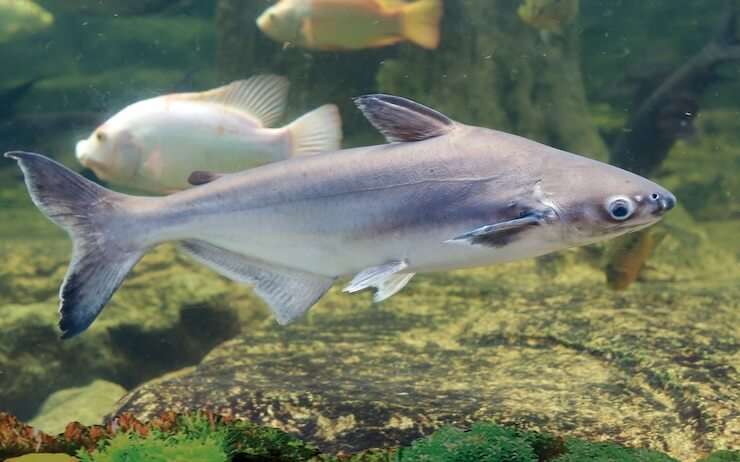
Size
51.1 inches
Physical Characteristics and Behavior
Iridescent sharks are among the freshwater fishes, and they are quite stunning. They stand out from the crowd in a way that no other catfish can equal thanks to their glittering, iridescent coloring. However, that is only accurate while the children are still very small. When they become adults, they all turn the same shade of gray. A juvenile’s body has two black stripes: one runs down the lower half of the body and the other down the lateral line. Fins that are very dark grey or black are present in juveniles and adults.
Keeping in a Tank

- Tank size
Juveniles are frequently offered for sale because they are cute and appealing, which attracts buyers. The sellers don’t specify how big the fish can go, though. Iridescent sharks grow very big, so they need tanks that are the right size. Additionally, because this fish prefers to live in schools, a tank needs a lot more area.
A 400 litre (88 gallon) tank is needed for the young fish, and a 1000 litre tank is needed for the adults (220 gallons). The pangasius shark is also very active, requires a lot of area to swim, and must only be housed in a school of its species.
- Tank Decoration
Because the fish are so energetic and nimble, they need a lot of space to swim, thus an oblong tank is ideal. Add some coarse sand and live tank plants to the tank’s bottom (you should fix them tightly to the bottom or put in small flower pots and dig into the substrate). Additionally, it is advisable to add some decorations to the tank, like stones, snags, or unusual-looking spade shelters. Be cautious when handling the latter, though, as iridescent sharks lack the bony plates that other fish have to protect their skin, making it relatively thin and vulnerable to injury. Choose ornaments that won’t harm the fish as a result.
- Water Conditions
These tropical fish prefer freshwater with a pH of 6.5 to 7.5, a hardness range of 2.0 to 29, and a temperature range of 22 to 26 degrees Celsius (72 to 79 degrees Fahrenheit).
- Feeding
is a fish that will devour anything it comes across. It is well known for this trait. Additionally, it is gluttonous. It consumes any kind of food in a tank, including live, frozen, flakes, and tablets. The optimal diet strategy is mixed feeding, which combines live and vegetable components.
Feed the iridescent shark once or twice daily, but only in portions that it can finish in five minutes. It is preferable to feed the fish protein-rich foods such as prawns, bloodworms, tiny fish, worms, and crickets. Give the plant squash, cucumbers, and lettuce leaves as food.
- Tank Companions
The juvenile iridescent sharks remain in a school, but as the fish becomes bigger, it increasingly prefers to stay by itself. With tank mates of the same size or fish that they can’t swallow, the iridescent shark does well when left alone. Any little fish are considered food for pangasius sharks. It might disrupt slower species or, conversely, it might be scared off by carnivorous and aggressive tank mates. is typically maintained alongside huge, moderately aggressive cichlids (Texas cichlid, Salvin’s cichlid), large catfish (common pleco, sailfin pleco), and bottom-lying fish (bichir, fire eel).
Table





